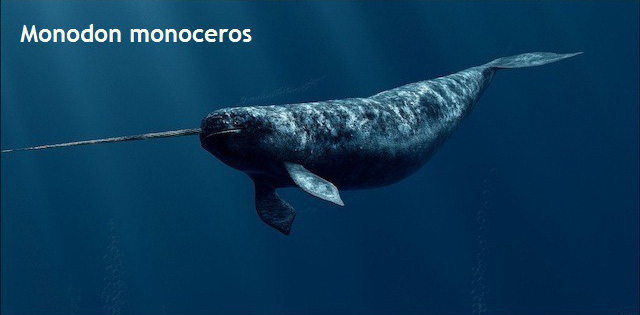The narwhal or narwhale (Monodon monoceros) is a medium-sized toothed whale that possesses a large “tusk” from a protruding canine tooth. It lives year-round in the Arctic waters around Greenland, Canada, and Russia. It is one of two living species of whale in the family Monodontidae, along with the beluga whale. The narwhal males are distinguished by a long, straight, helical tusk, which is an elongated upper left canine. The narwhal was one of many species described by Carl Linnaeus in his publication Systema Naturae in 1758.
Like the beluga, narwhals are medium-sized whales. For both sexes, excluding the male’s tusk, the total body size can range from 3.95 to 5.5 m (13 to 18 ft); the males are slightly larger than the females. The average weight of an adult narwhal is 800 to 1,600 kg (1,760 to 3,530 lb). At around 11 to 13 years old, the males become sexually mature; females become sexually mature at about 5 to 8 years old. Narwhals do not have a dorsal fin, and their neck vertebrae are jointed like those of most other mammals, not fused as in dolphins and most whales.
Found primarily in Canadian Arctic and Greenlandic and Russian waters, the narwhal is a uniquely specialized Arctic predator. In winter, it feeds on benthic prey, mostly flatfish, under dense pack ice. During the summer, narwhals eat mostly Arctic cod and Greenland halibut, with other fish such as polar cod making up the remainder of their diet.[5] Each year, they migrate from bays into the ocean as summer comes. In the winter, the male narwhals occasionally dive up to 1,500 m (4,920 ft) in depth, with dives lasting up to 25 minutes. Narwhals, like most toothed whales, communicate with “clicks”, “whistles”, and “knocks”.
Narwhals can live up to 50 years. They are often killed by suffocation after being trapped due to the formation of sea ice. Other causes of death, specifically among young whales, are starvation and predation by orcas. As previous estimates of the world narwhal population were below 50,000, narwhals are categorized by the International Union for Conservation of Nature (IUCN) as “nearly threatened”. More recent estimates list higher populations (upwards of 170,000), thus lowering the status to “least concern”.[4] Narwhals have been harvested for hundreds of years by Inuit people in northern Canada and Greenland for meat and ivory, and a regulated subsistence hunt continues.
























